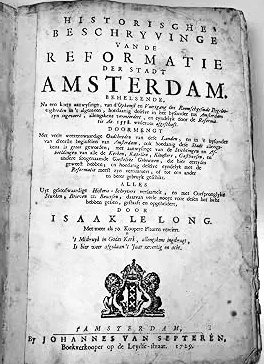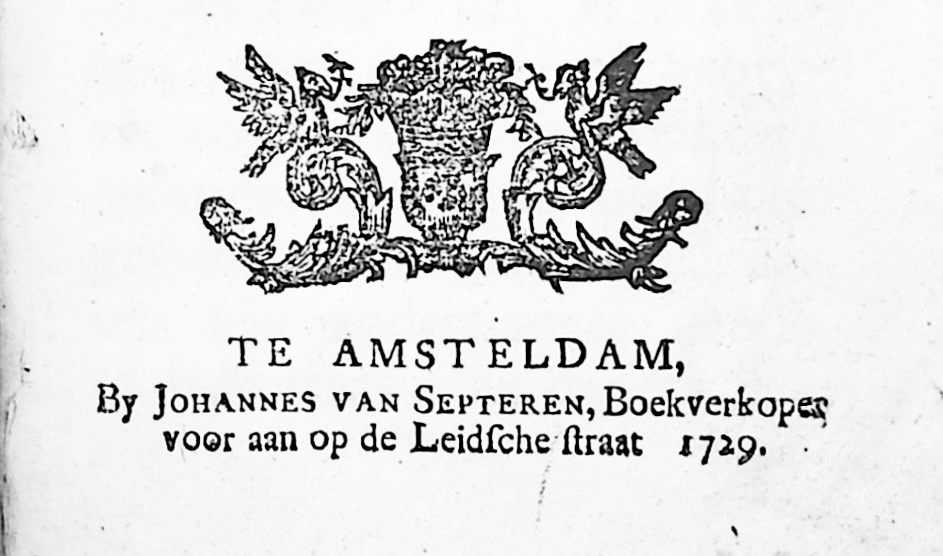Three centuries ago, in 1721, a 21-year-old young man named Johannes van Septeren established a publishing house and bookselling business in Amsterdam. He published high volumes of books on religion, spirituality, history and science as well as etches, drawings, maps, poetry and art pieces that were relevant for people at that time. After five years of intensive publishing and bookselling, competitors and government officials started keeping more than a close eye on Van Septeren.
Van Septeren had many valuable works translated from German, English, Italian and Latin into Dutch, including writings by pastor and hymnist Erdmann Neumeister (1671-1756) who inspired J.S. Bach, as well as books by the English theologian and geologist Thomas Burnet (ca. 1635-1715), who had written about the illogical denial of the spirituality of the scriptures and who was admired by Isaac Newton and poet Samuel Taylor Coleridge alike. Van Septeren published those writings by Burnet that, as his English publisher described, had previously remained unpublished due to sabotage by “thief-like hands”.(1)
In 1727, Van Septeren was summoned by a local sheriff for publishing a poem about the death of the British King George I – a poem that officials described as slanderous.(2) Things quickly got worse after that.
In 1728 Van Septeren found himself in a conflict with three other booksellers who were accusing one of his authors, the historian and bibliographer Isaac Le Long (1683-1762), of using architectural information to which the city government had given them the copyright. Le Long’s forthcoming book was about the history of the Reformation in Amsterdam, including details about the notary Nicolaas Listingh (1630-1705) who had designed a huge round cathedral in Amsterdam. While the cathedral was never built, Listingh’s proposal remained notorious. Listingh had also been a friend and confidant to painter Rembrandt van Rijn (1606/7-1669); as a curator he had helped him during his bankruptcy by allocating some of his possessions to his son and his wife.

The three booksellers threatened Van Septeren not to publish Le Long’s book, which was announced to go on sale on December 8, 1728. In response to them he published the book a day early, on December 7. Mayhem ensued. The booksellers and their lawyer placed an advertisement warning the public not to buy the book because it had been made in a “selfish and malicious manner” and announcing that they would soon publish a much more valuable book on the history of Amsterdam that “within the year 1729 will see the light in unequalled splendor and substance”.(3)
Le Long explained in a “message to the reader” that those whom he had considered friends had betrayed him; that they had freely provided him with information that he had not asked for, before trying to gain information from him in return, which he had declined. Van Septeren settled on Christmas eve; he agreed to handing over the copyright and the printing plates and to paying the three booksellers 750 guilders in the following year. The book they had said they were working on never appeared.
Then, in 1729, Van Septeren was fined one thousand guilders for not mentioning the name of the author and the printer of a satirical essay with a title that included the words “the solemn failures of the papacy and the religious state”.(4) Not long after that, the three booksellers came to collect their 750 guilders but Van Septeren did not pay, he claimed insolvency. His business was bankrupt, he declared; losing the copyright to the book that had been so costly to make had caused a major financial loss; the advertisement had ruined the good name of his business; prices of his existing books were lowered. The legal archive shows that he was chased by various creditors who wanted their money back: printers and print plate cutters, paper suppliers, booksellers, investors, authors, translators and the landlord of his bookstore and his office. All of his possessions were auctioned, including bookbinding tools, old Bibles, religious texts, maps, art works, architectural drawings and unpublished writings.
There is a testimony from his former maid that Van Septeren had become a lousy father to his only son, 9-year-old Abraham, whose mother had died. He was acting irresponsibly and drinking heavily, she said, sleeping in the hallway of a shelter, and on one occasion disappearing without a trace for nine days and nine nights, returning “without his pocketwatch, his silver penholder and even the buckles of his shoes.”(5) A few years later Johannes van Septeren died in 1739 in Cape Town, around age 40, while working as a soldier for the Dutch East India Company. His son Abraham died in 1745, around age 24, while working as a soldier for the same company, on a ship enroute to Cape Town.(6)
No record of Van Septeren exists today except a few archives and his name on his publications. It is mostly in secondhand shops and markets where one is still able to find soul nourishing books, books like those made by Johannes van Septeren three hundred years ago, which, despite their old age, remain regularly available on secondhand markets.
Old Revolutions Press offers a honorary tin medal to whomever finds the King George poem.
~
(1) Burnet, Thomas. De gemeene dwalingen der Christenen, betreffende den staat der dooden, der opstanding en het aanstaande leven. Johannes van Septeren, Amsterdam, 1729. (Free digital Dutch book). In the preface, the English publisher wrote that the assertions made by publishers on the reasons why parts of Burnet’s writings had remained unpublished are false, and that he had learned from Burnet himself that it had been due to “thief-like hands”.
(2 + 3) Cited in: Van Eeghen, Isabella Henrietta. De Amsterdamse boekhandel 1680-1725. Deel 4. Gegevens over de vervaardigers, hun internationale relaties en de uitgaven N-W, papierhandel, drukkerijen en boekverkopers in het algemeen. Scheltema & Holkema, Amsterdam, 1967. (Digital chapter on Van Septeren). While it appeared on December 7, 1928, Le Long’s book is dated 1729.
(4) The Dutch title: Solemneele versakinge van het pausdom en den geestelijken staat geregtelijk gedaan door Lucas Ahuys Janseniste priester te Amsterdam anno 1729.
(5) Stadsarchief Amsterdam: A notarized testimony given on January 10, 1731, by Van Septeren’s former maid upon the request of Abraham’s maternal grandfather.
(6) Nationaal Archief on the Dutch East India Company: the digital record on Johannes van Septeren and the digital record on Abraham van Septeren.
